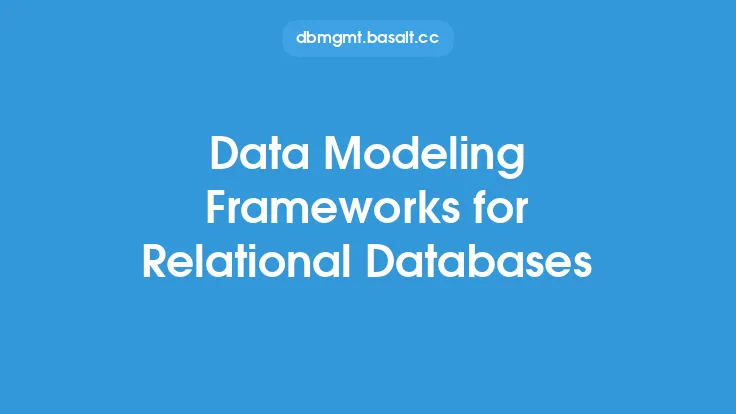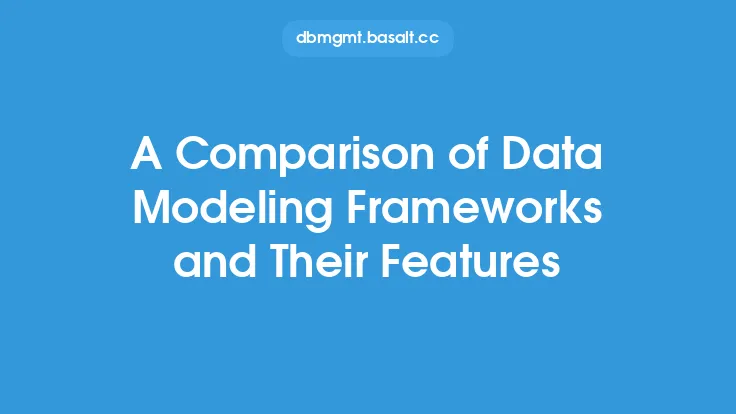When designing a database system, one of the most critical aspects to consider is scalability and flexibility. As the amount of data grows, the database system must be able to handle the increased load without compromising performance. This is where data modeling frameworks come into play. A well-designed data modeling framework can help create a scalable and flexible database system that can adapt to changing requirements.
Key Components of a Data Modeling Framework
A data modeling framework typically consists of several key components, including a conceptual model, a logical model, and a physical model. The conceptual model represents the overall structure and organization of the data, while the logical model provides a more detailed representation of the data entities and their relationships. The physical model, on the other hand, defines the actual storage and retrieval mechanisms for the data. A good data modeling framework should provide a clear and consistent way of defining these components, ensuring that the database system is scalable, flexible, and easy to maintain.
Data Abstraction and Normalization
Data abstraction and normalization are two essential concepts in data modeling frameworks. Data abstraction refers to the process of representing complex data entities in a simplified and abstract way, making it easier to manage and maintain. Normalization, on the other hand, involves organizing data into tables and relationships to minimize data redundancy and improve data integrity. A data modeling framework should provide a clear and consistent way of applying these concepts, ensuring that the database system is optimized for performance and scalability.
Entity-Relationship Modeling
Entity-relationship modeling is a fundamental concept in data modeling frameworks. It involves identifying and defining the entities and relationships that exist within the data, and representing them in a clear and concise way. A good data modeling framework should provide a robust entity-relationship modeling capability, allowing designers to create complex data models that accurately reflect the underlying data structures. This includes support for entities, attributes, relationships, and constraints, as well as the ability to define complex relationships and hierarchies.
Object-Relational Mapping
Object-relational mapping (ORM) is a critical component of many data modeling frameworks. ORM provides a way of mapping objects in the application code to tables and relationships in the database, making it easier to interact with the data and reducing the amount of boilerplate code required. A good data modeling framework should provide a robust ORM capability, allowing designers to define complex mappings and relationships between objects and tables. This includes support for inheritance, polymorphism, and composition, as well as the ability to define custom mappings and transformations.
Data Validation and Constraints
Data validation and constraints are essential components of a data modeling framework. They provide a way of ensuring that the data is accurate, consistent, and valid, and help to prevent data corruption and errors. A good data modeling framework should provide a robust data validation and constraint capability, allowing designers to define complex rules and constraints that govern the data. This includes support for data types, ranges, and formats, as well as the ability to define custom validation rules and constraints.
Data Modeling Frameworks and Database Design
A data modeling framework plays a critical role in database design, as it provides a way of defining the structure and organization of the data. A good data modeling framework should provide a clear and consistent way of defining the database schema, including the tables, relationships, and constraints. This includes support for database design patterns and principles, such as normalization, denormalization, and data warehousing. By using a data modeling framework, designers can create a scalable and flexible database system that meets the needs of the application and the users.
Best Practices for Implementing a Data Modeling Framework
Implementing a data modeling framework requires careful planning and attention to detail. Some best practices to keep in mind include starting with a clear understanding of the data and the application requirements, using a consistent and robust data modeling notation, and defining a clear and concise data model that accurately reflects the underlying data structures. It's also important to consider the scalability and flexibility requirements of the database system, and to use a data modeling framework that provides a clear and consistent way of defining the database schema. By following these best practices, designers can create a scalable and flexible database system that meets the needs of the application and the users.
Common Challenges and Pitfalls
When implementing a data modeling framework, there are several common challenges and pitfalls to watch out for. One of the most common challenges is data complexity, which can make it difficult to define a clear and concise data model. Another challenge is data inconsistency, which can occur when the data is not properly validated and constrained. To avoid these challenges, it's essential to use a robust data modeling framework that provides a clear and consistent way of defining the data model, and to carefully plan and design the database schema. Additionally, it's essential to test and validate the data model thoroughly, to ensure that it accurately reflects the underlying data structures and meets the needs of the application and the users.
Future Directions and Trends
The field of data modeling frameworks is constantly evolving, with new trends and technologies emerging all the time. Some of the future directions and trends to watch out for include the increasing use of cloud-based databases, the rise of NoSQL and NewSQL databases, and the growing importance of data governance and data quality. Additionally, there is a growing trend towards using data modeling frameworks that provide a more agile and iterative approach to database design, such as agile data modeling and DevOps. By staying up-to-date with these trends and technologies, designers can create scalable and flexible database systems that meet the needs of the application and the users, and that are well-positioned for future growth and evolution.





